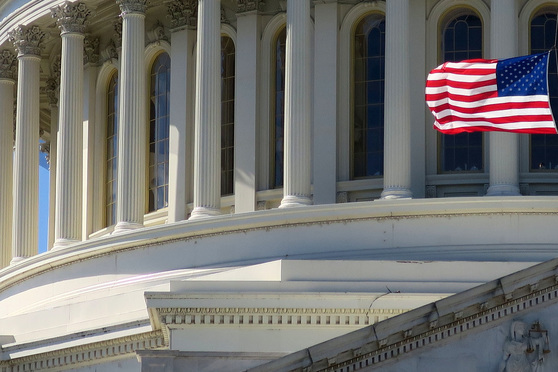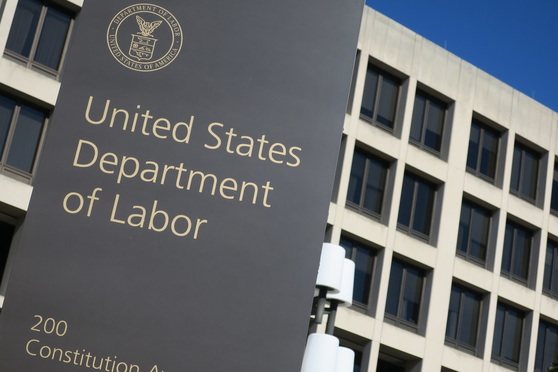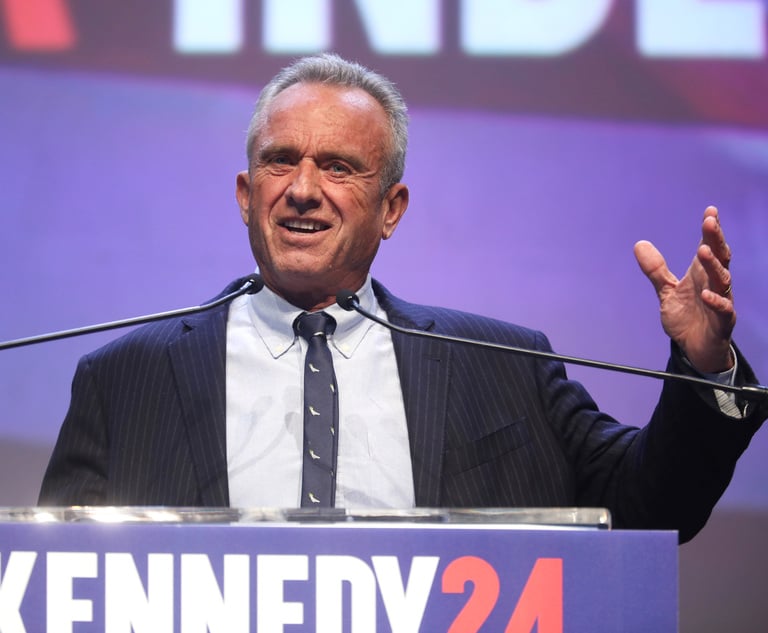Employment Law Implications After US House Flips to Dems
Divided Congress might not mean substantive legislation—but then there's messaging of progressive ideas and oversight.
November 07, 2018 at 07:40 PM
7 minute read
 U.S. Capitol. Credit: Mike Scarcella/ NLJ
U.S. Capitol. Credit: Mike Scarcella/ NLJ
Tuesday's midterm election tees up a tug-of-war between the new Democratic majority in the U.S. House and the strengthened Republican majority in the Senate. This may mean little substantive policy action on employment issues, but the new dynamic is expected to put a new focus on progressive issues and slow the Trump administration's deregulatory agenda.
The Democrats will now have a platform to champion progressive employment laws focused on high-profile topics, and they now have oversight power that could put a spotlight on key Trump regulatory officials and their pro-business leanings.
After Midterms, Lawyers and Lobbyists Look for Opportunities in Divided Government
“A lot of times politicians like to have an issue rather than solve a problem. The House Democrats will have the benefit of the spotlight,” said Scott Witlin, partner at Barnes & Thornburg in Los Angeles. “They will have to decide if they want to get things accomplished or use their newly gained power for publicity.”
He added, “In the labor and employment area, Democrats and Republicans are often critically divided. The conventional wisdom is that there is division, and little will get done. The wild card is if the president can use the division to negotiate beyond gridlock.”
Here are some of the implications on the labor and employment front.
>> Watch for House Democrats to push worker-friendly bills.
House Democrats will now have leverage to pass worker-friendly legislation that—thanks to the divide on Capitol Hill—probably won't stand a chance in the Senate. Still, pushing legislation—complete with hearings and press releases—tees up Democratic-focused issues ahead of the 2020 election. Democrats could be expected to push legislation at combating sexual harassment, empowering unions, raising the minimum wage and offering greater protections to workers in the gig economy.
“Those that don't really understand the way it works will say, 'There will be gridlock because nothing with pass the Senate.' The president won't sign,'” said Michael Lotito, co-chair of Littler Mendelson's Workplace Policy Institute. “What people do not see is that this begins a process with respect to messaging. These ideas could morph into accepted dogma.”
Democrats “are the ones driving the agenda. They will have additional staff to develop concepts. On top of that, there are oversight committees, subpoenas. It puts the minority in a difficult position,” Lotito said.
Randel Johnson, practice chair of Seyfarth Shaw's government relations and policy group, said Democrats won't be able to budge some of the substantive labor laws on the books for years.
King & Spalding partner Cheryl Sabnis said overtime and minimum wage issues may be ripe for a middle ground.
“Those issues can come down to dollars and cents. General parameters and agreements can be reached,” she said. “What's difficult is when you get into areas of broad disagreement for people based on party lines, such as LGBTQ rights, protections for women in the workplace and progressive employment laws such as paid family leave and child care.”
Rich Meneghello and Ben Ebbink of Fisher & Phillips said in a recent blog post that the House may target measures that limit arbitration, especially after a Supreme Court ruling last year that said employers can restrict class actions through the use of mandatory arbitration agreements in employment contracts.
Other potential focus points, the Fisher Phillips lawyers predicted, could be aimed at limiting right-to-work laws, streamlining union organizing and providing more protections for independent contractors who work in the gig economy.
“However, most of these actions would be largely symbolic and would amount to nothing in the end. The Republican Party continues to control the Senate, and in fact expanded their slim margin of power in yesterday's election,” the attorneys wrote. “There is almost no scenario imaginable where any of these measures would clear the Senate hurdle, although a more moderate increase to the federal minimum wage might not be out of the question.”
>> Increased regulatory oversight is likely.
The House Democratic majority might find greater immediate impact through oversight—holding hearings that force Trump's regulatory and enforcement leaders to explain what they are doing and why they are doing it.
“There is no question that House having oversight authority will put a damper on regulatory changes that this administration will pursue,” Johnson of Seyfarth Shaw said. “When you are in the agencies, you start questioning, 'Should we do X? Well, my boss will have to defend this on Capitol Hill. He'll have to explain the minutia. Will my boss want to do that?'” He added, “This administration has been spoiled not having to think of that.”
 U.S. Labor Department headquarters in Washington. Credit: Mike Scarcella
U.S. Labor Department headquarters in Washington. Credit: Mike ScarcellaThe House could also attach appropriation riders to spending bills to cut from measures or agencies passing regulatory agendas the Democrats do not support. That “power of the purse” could prove a significant leverage, Johnson said.
Meanwhile, the Senate's stronger majority won't be hampered in pushing through appointments to key positions in federal agencies. The greater divide in the Senate—Republicans will hold more seats in 2019 than they do now—gives some room to lose a vote here and there but still confirm a Trump nominee. Two Equal Employment Opportunity Commission nominees still are awaiting Senate confirmation.
The Labor Department's effort to create a new overtime rule and the National Labor Relations Board's move to scrap the Obama-era “joint employment” standard both could come into scrutiny in the House next year. Both areas were the focus of court cases—and Democrats have decried the actions taken by Trump's agencies to adopt more business-friendly approaches.
>> Gridlock at the federal level puts an even greater focus on the states.
Littler Mendelson's Lotito predicted any gridlock at the federal level will push states to be more active in the labor and employment space. Progressive state lawmakers have pushed bills addressing paid leave, minimum wage and gender equity issues.
Worker-friendly states such and New York and California are expected to lead the way and create a template for other states, said King & Spalding's Sabnis. “What we are likely to see as a result of the midterm elections is that states continue to raise the bar on employee protective issues even where the federal government might not and thereby force employers who operate across the country to improve on their own practices,” Sabnis said. “This is a trend that we've seen over the last few years.”
Read more:
Uber's Attorneys Move to Disqualify Ex-Chamber Lawyer Now on Plaintiffs Side
Justice Dept. Takes Stance Against Transgender Rights—and the EEOC—in Supreme Court
Business Groups Press Supreme Court to Reverse Gender-Pay Ruling
➤➤ Get employment law news and commentary straight to your inbox with Labor of Law, a new Law.com briefing. Learn more and sign up here.
This content has been archived. It is available through our partners, LexisNexis® and Bloomberg Law.
To view this content, please continue to their sites.
Not a Lexis Subscriber?
Subscribe Now
Not a Bloomberg Law Subscriber?
Subscribe Now
NOT FOR REPRINT
© 2025 ALM Global, LLC, All Rights Reserved. Request academic re-use from www.copyright.com. All other uses, submit a request to [email protected]. For more information visit Asset & Logo Licensing.
You Might Like
View All
RFK Jr. Will Keep Affiliations With Morgan & Morgan, Other Law Firms If Confirmed to DHHS
3 minute read
Read the Document: DOJ Releases Ex-Special Counsel's Report Explaining Trump Prosecutions
3 minute read
3rd Circuit Nominee Mangi Sees 'No Pathway to Confirmation,' Derides 'Organized Smear Campaign'
4 minute read
Judge Grants Special Counsel's Motion, Dismisses Criminal Case Against Trump Without Prejudice
Trending Stories
Who Got The Work
J. Brugh Lower of Gibbons has entered an appearance for industrial equipment supplier Devco Corporation in a pending trademark infringement lawsuit. The suit, accusing the defendant of selling knock-off Graco products, was filed Dec. 18 in New Jersey District Court by Rivkin Radler on behalf of Graco Inc. and Graco Minnesota. The case, assigned to U.S. District Judge Zahid N. Quraishi, is 3:24-cv-11294, Graco Inc. et al v. Devco Corporation.
Who Got The Work
Rebecca Maller-Stein and Kent A. Yalowitz of Arnold & Porter Kaye Scholer have entered their appearances for Hanaco Venture Capital and its executives, Lior Prosor and David Frankel, in a pending securities lawsuit. The action, filed on Dec. 24 in New York Southern District Court by Zell, Aron & Co. on behalf of Goldeneye Advisors, accuses the defendants of negligently and fraudulently managing the plaintiff's $1 million investment. The case, assigned to U.S. District Judge Vernon S. Broderick, is 1:24-cv-09918, Goldeneye Advisors, LLC v. Hanaco Venture Capital, Ltd. et al.
Who Got The Work
Attorneys from A&O Shearman has stepped in as defense counsel for Toronto-Dominion Bank and other defendants in a pending securities class action. The suit, filed Dec. 11 in New York Southern District Court by Bleichmar Fonti & Auld, accuses the defendants of concealing the bank's 'pervasive' deficiencies in regards to its compliance with the Bank Secrecy Act and the quality of its anti-money laundering controls. The case, assigned to U.S. District Judge Arun Subramanian, is 1:24-cv-09445, Gonzalez v. The Toronto-Dominion Bank et al.
Who Got The Work
Crown Castle International, a Pennsylvania company providing shared communications infrastructure, has turned to Luke D. Wolf of Gordon Rees Scully Mansukhani to fend off a pending breach-of-contract lawsuit. The court action, filed Nov. 25 in Michigan Eastern District Court by Hooper Hathaway PC on behalf of The Town Residences LLC, accuses Crown Castle of failing to transfer approximately $30,000 in utility payments from T-Mobile in breach of a roof-top lease and assignment agreement. The case, assigned to U.S. District Judge Susan K. Declercq, is 2:24-cv-13131, The Town Residences LLC v. T-Mobile US, Inc. et al.
Who Got The Work
Wilfred P. Coronato and Daniel M. Schwartz of McCarter & English have stepped in as defense counsel to Electrolux Home Products Inc. in a pending product liability lawsuit. The court action, filed Nov. 26 in New York Eastern District Court by Poulos Lopiccolo PC and Nagel Rice LLP on behalf of David Stern, alleges that the defendant's refrigerators’ drawers and shelving repeatedly break and fall apart within months after purchase. The case, assigned to U.S. District Judge Joan M. Azrack, is 2:24-cv-08204, Stern v. Electrolux Home Products, Inc.
Featured Firms
Law Offices of Gary Martin Hays & Associates, P.C.
(470) 294-1674
Law Offices of Mark E. Salomone
(857) 444-6468
Smith & Hassler
(713) 739-1250








